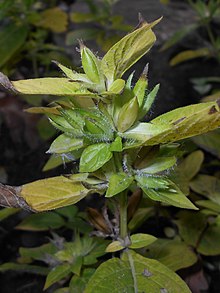| Ruellia strepens | |
|---|---|

| |
| Botanical illustration | |

| |
| Flowers budding | |
| Conservation status | |
 Apparently Secure (NatureServe) | |
| Scientific classification | |
| Kingdom: | Plantae |
| Clade: | Tracheophytes |
| Clade: | Angiosperms |
| Clade: | Eudicots |
| Clade: | Asterids |
| Order: | Lamiales |
| Family: | Acanthaceae |
| Genus: | Ruellia |
| Species: | R. strepens |
| Binomial name | |
| Ruellia strepens L. | |
| Synonyms | |
List
| |
Ruellia strepens, commonly known as limestone wild petunia, limestone ruellia, smooth wild petunia, or wild petunia is a species of flowering plant in the family Acanthaceae, native to warmer parts of the central and eastern United States. A perennial herb, it prefers to grow in moist to mesic, partly shady areas such as streamsides and bottomland forests. In the garden it is hardy to USDA zone 5, and can tolerate nearly full shade.
Description
R. strepena grows up to 1 m (3 ft) tall, branching occasionally. The green stems either smooth or sparsely hairy. The leaves are opposite on the stem, have short petioles, and are lanceolate or ovate, tapering to a sharp point at the end. They measure up to 13 cm (5 in) long and 8 cm (3 in) across. Their margins are smooth or slightly undulate.
The flowers are lavender to bluish, growing from nodes near the middle of the stems. They have 5 flaring lobes and are tubular, measuring up to 5 cm (2 in) long.
Although many herbaceous plants cease growing or even die back after blooming, R. strepens continues to get bigger as its fruits mature, resulting in late season plants that might be twice as tall as they were when flowering.
Etymology
The genus name Ruellia honors Jean Ruelle, a French physician and botanist (1474 – 1537). Its specific epithet strepens refers to the rustling noises the plant's seeds make as they uncoil and bury themselves into the ground.
Distribution and habitat
R. strepena is native in the United States from Nebraska to the west, Texas and Florida to the south, Michigan and Pennsylvania to the north, and the east coast to the east. It is listed as endangered in Michigan and North Carolina and critically imperiled in South Carolina. It lives in bottomland forests, rich upland forests, river and stream banks, and edges of ponds and lakes. It can also be found occasionally in bottomland prairies and fens, pastures, moist roadsides, and railroads.
References
- ^ "Ruellia strepens L." Plants of the World Online. Royal Botanic Gardens, Kew. Retrieved 24 October 2022.
- ^ "Ruellia strepens". explorer.natureserve.org. NatureServe Explorer 2.0.
- ^ "Ruellia strepens". Plant Database. Lady Bird Johnson Wildflower Center. 18 June 2015. Retrieved 24 October 2022.
- ^ "Smooth Wild Petunia (Ruellia strepens)". www.illinoiswildflowers.info.
- ^ "Ruellia strepens page". www.missouriplants.com.
- ^ "Ruellia strepens". Plant Finder. Missouri Botanical Garden. Retrieved 24 October 2022.
...commonly called wild petunia or smooth ruellia
- Denison, Edgar (2017). Missouri Wildflowers (Sixth ed.). Conservation Commission of the State of Missouri. p. 98. ISBN 978-1-887247-59-7.
- "SEINet Portal Network - Ruellia strepens". swbiodiversity.org.
- "Michigan's Rare Plants - Michigan Natural Features Inventory". mnfi.anr.msu.edu.
- "Home | North Carolina Natural Heritage Data Explorer". ncnhde.natureserve.org.
- "SC Natural Heritage Program". schtportal.dnr.sc.gov.
- "Wild Petunia (Smooth Ruellia)". Missouri Department of Conservation.
| Taxon identifiers | |
|---|---|
| Ruellia strepens |
|
- NatureServe apparently secure species
- Ruellia
- Endemic flora of the United States
- Flora of Nebraska
- Flora of Kansas
- Flora of Oklahoma
- Flora of Texas
- Flora of Iowa
- Flora of Missouri
- Flora of Illinois
- Flora of Indiana
- Flora of Michigan
- Flora of Ohio
- Flora of West Virginia
- Flora of Pennsylvania
- Flora of New Jersey
- Flora of the Southeastern United States
- Plants described in 1753
- Taxa named by Carl Linnaeus